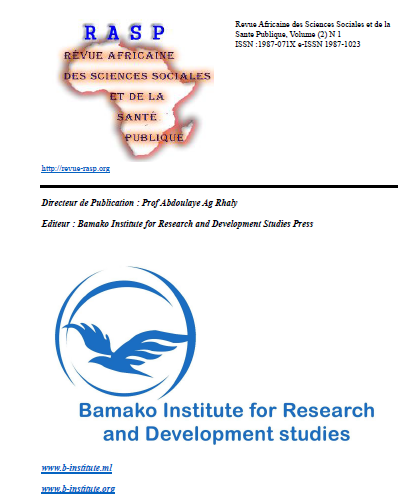Internal migration and creation of informal economic activities in the district and peri-urban areas of Bamako-Mali
Keywords:
Bamako District, peri-urban areas, actions, internal migrants, informal activities, MaliAbstract
This article aims to highlight the contribution of internal migrants in the creation of informal economic activities in the district and peri-urban areas of Bamako. Malian migration is a historical fact. It is part of a tradition of mobility. Mali, a continental, Sahelo-Saharan and highly landlocked country. Faced with this territorial constraint, populations have adopted migration, mobility and transhumance as an alternative for survival. It is part of household survival strategies. Formerly oriented towards nearby neighboring countries, nowadays a significant number of flows are directed towards the district of Bamako. The district of Bamako owed its dynamism to the massive arrival of rural populations due to the consequences of the drought which severely hit the rural world, and forced populations into exile. The centrality of socio-economic infrastructure in the district of Bamako to the detriment of other economic centers had as a direct consequence the arrival of migrant populations. In Mali, with the increase in urban unemployment and the low absorption capacity of the formal sector, urban populations have resorted to the informal sector. It has contributed to absorbing unemployment in Bamako. It is the leading sector providing employment. The massive influx of internal migrants has greatly contributed to the proliferation of informal activities in the district of Bamako. Unskilled migrants have resorted to this sector to integrate into the urban economic fabric. The methodology is based on interviews, direct observation, a literature review, a quantitative survey using a questionnaire, and a qualitative survey conducted through an interview guide. According to the field results, (56.22%) of the migrants surveyed are in the informal sector and (43.77%) are in the formal sector.
References
ANTOINE P., OUEDRAOGO D., PICHE V., 1998, Trois générations de citadins au Sahel, L’Harmattan, collection villes et entreprise, 276 p.
BALLO M., 2009, Migration au Mali : Profit national pour le développement de politiques stratégique OIT, Bamako, 127p.
BOUJU J., 2000, Clientélisme, corruption et gouvernance locale à Mopti-Mali, Autrepart, (14) p.143-163, Jolivet Marie-José (éd.). ISBN 2-87678-555-2
CISSE P., 2005, Organisation sociale et accès aux ressources « cas des migrants commerçants maliens à Douala et Yaoundé », (Cameroun), Bamako, CNRST, 14p.
CHARMES J., (BAD et le CRES) et NIDHAL. B.C., (CRES), 2016, Protection sociale et économie informelle en Tunisie: Défis de la transition vers l’économie formelle.
DOUGNON I., 2007, Travail des blanc, travail de noir : la migration des paysans dogons vers l’office du Niger et au Ghana (1910-1980) Paris, Karthala, 279p.
FALL. A. S, 1991, Réseaux de sociabilité et insertion urbaine dans l’agglomération de Dakar, thèse de doctorat de 3cycle, Université Cheick ANTA DIOP, Sénégal, 420p.
KANTE S., 2002, Le secteur informel en Afrique subsaharienne francophone, Genève, Bureau international du travail, 70p.
MOEN P., et WETHINGTON E., 1992, « The concept of family adaptatives strategies in annuaires review of sociology », n°18, pp. 233-521.
TODARO M. 1969, et HARRIS R. G., 1970, Migra PNUD., 1996, Croissance économique et développement humain, Economica, Paris, 251p RGPH, (2009), Recensement général de la population et de l’habitat du Mali, 57p.
TRAORE M., et SISSOKO Y., 2010, Les institutions du marché du travail face aux défis du développement : cas du Mali, 85p
TRAORE S., 1993, Réseau de recherche sur les migrations et l’urbanisation au Sahel : Etat des connaissances, Etudes et Travaux du CERPOD, n° 14, Bamako.
OBERAI A.S, MANMOHAN S., 1984, « Les migrations, l’emploi et le marché du travail urbain », Cas du Pendjab indiens dans la revue internationale du travail, juillet- Aout, pp. 553-572.
OUEDRAOGO M., 2001, « Migration et emploi : le cas du secteur informel à Bobo-Dioulasso », Mémoire de Maitrise, Université de Ouagadougou, 135p.
ZOURKALEINI Y. et VICTOR P., 2005, « Migration et emploi urbain, cas de Ouagadougou au Burkina Faso », Africain population studies vol.20 n°1, 19p.
Downloads
Published
Versions
- 2025-10-23 (2)
- 2020-03-22 (1)
How to Cite
Issue
Section
License

This work is licensed under a Creative Commons Attribution 4.0 International License.
https://creativecommons.org/licenses/by/4.0/
You are free to:
- Share — copy and redistribute the material in any medium or format
- Adapt — remix, transform, and build upon the material for any purpose, even commercially.
- The licensor cannot revoke these freedoms as long as you follow the license terms


